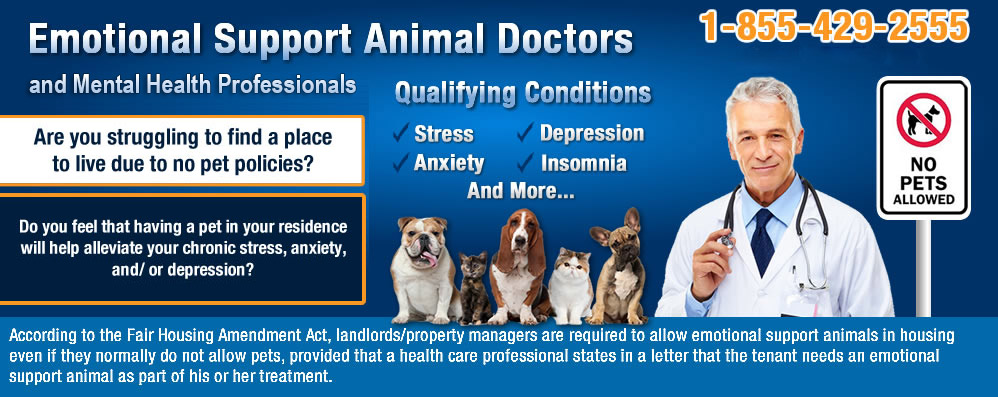Contents
Emotional Support Animal Vests, Harnesses & Patches
Although an emotional support animal (ESA) is not required to display any identification, many people choose to have their ESA wear an emotional support animal vest, patch or harness.
With noticeable identification, your animal can be easily recognizable as being more than just a pet. Along with this being helpful with landlords and airline personnel, this will also help others understand why you have an animal in a situation they might not expect animals to be allowed.
Reasons to Identify Your ESA
- It lets everyone know that your emotional support animal is more than just a pet.
- It helps landlords, airline staff, law enforcement and other members of the public look for your ESA in case it gets lost.
- It limits having to explain to others that your pet is an ESA, which in many situations, such as flying, can be exhausting.
- It reduces the number of people who try to pet and interact with your ESA which can be distracting for it, potentially reducing its ability to address the symptoms of your condition.
ESA Vest
While your pet’s ESA vest should be chosen for identification purposes, other considerations should include:
- Proper fit – appropriate for the size of your ESA
- Proper material – a light mesh for hot and humid climates. For other climates, consider cotton or another breathable fabric, avoiding synthetic fabrics that might be less comfortable. You might have different vests for different weather conditions.
- Identification – choose the ID that you feel best describes your ESA, such as “support animal” or “working animal.” Do not mis-identify your emotional support animal as a service animal. Service animals are covered under different laws than ESAs, require specific training, and have different privileges.
Some vests have features that might be important to you, such as:
- A pocket for ID
- Removable/replaceable patches
- Handle for greater control or training
- Areas with reflective material for better visibility at night
- Adjustable and/or padded straps
ESA Harness
Some pet owners prefer a harness over a vest for ESAs that are larger and might require more control or training. Emotional support harnesses typically include a loop for a leash which can help you keep your ESA in control while in public. Leashes with imprints, such as “Emotional Support Animal” are available to pair with your ESA harness.
Some harnesses have features that might be important to you, such as:
- Ring for clipping on licenses and ID tags
- Handle for greater control or training
- Areas with reflective material for better nighttime visibility
- Padded and/or adjustable straps
- Fast drying materials
ESA Patch
Emotional support animal patches are available in a number of styles and materials including printed, embroidered and metallic. One of the first choices when selecting an ESA patch is: Velcro or sew-on. While the Velcro is convenient and allows for easy replacement, some feel that Velcro patches tend to fit loosely and look less professional if they curl on the edges.
When deciding on an ESA patch, consider:
- Size – proper fit on ESA vest or ESA harness
- Visibility – easy to see and read
- Application – sew-on, Velcro
- Durability
- Quality – high quality can support credibility
Also, choose an ESA patch (or patches) that communicates the message(s) you want understood, such as “Emotional Support Animal” and/or “Working Animal” and/or “Do Not Pet” and/or “Support Animal” and/or “Please Do Not Pet Me. I’m Working.”
Wearable Identification is Not Enough
Just outfitting a pet with ESA identification does not make them a recognized emotional support animal that is qualified for housing and airline privileges. For your pet to be an ESA, you need an official ESA letter from a licensed mental health professional.
The DOGtor offers a simple and affordable way for you to quickly get a properly formatted ESA letter. Take the first step in getting your pet qualified as an Emotional Support Animal today.
Emotional
Dogs
Companions
Services
Support
Animal
Animal
Florida
Flying
Documentation
Form
California
ADA
Cat
Certificate
Harness
HousingLaws
Iowa
Laws
LetterHousing
LetterPresciption
LetterSample
LetterTemplate
LandlordLetter
Letter
Patch
Prescription
Planes
Vest
Training
Texas
Rights
Requirements
Registry
Registration
RegistrationAmerica
Dog
Dog
Certification
CertificationOnline
Vests
Training
Requirements
Registration
Plane
Licence
Letter
LetterTemplate
Laws
Harness
ForSale
Certificate
California
Breeds













